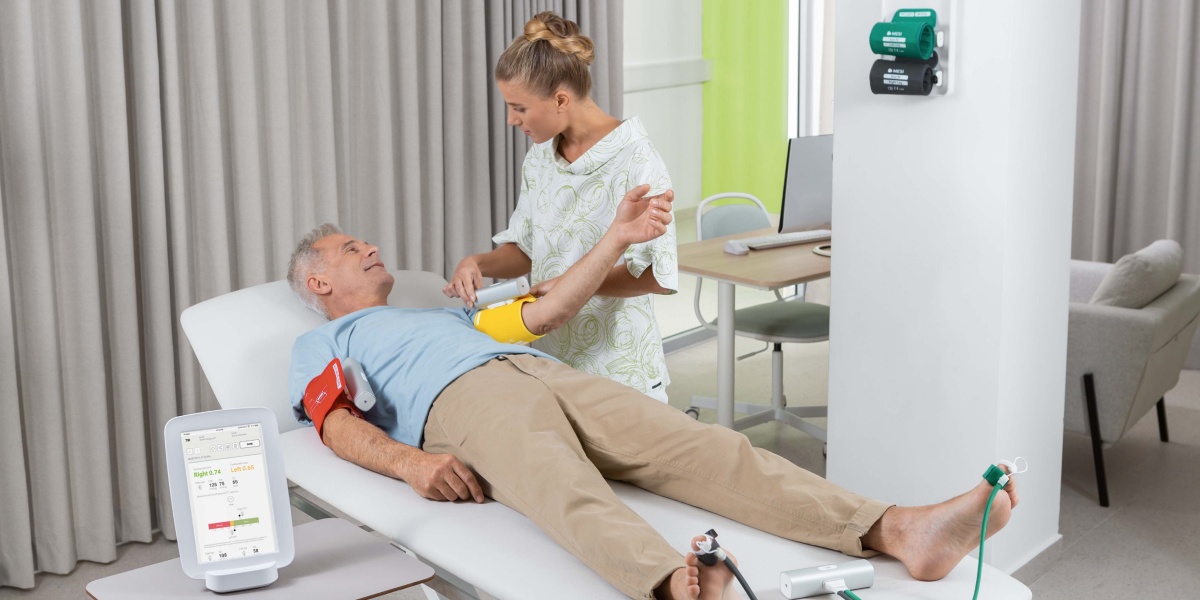Importance of the Toe-Brachial Index (TBI) measurement for diabetic patients

Timely diagnosis of peripheral artery disease (PAD) and a well-formulated treatment and management plan is of the greatest importance for every patient, but even more for those with comorbid diabetes mellitus. Namely, it has a disruptive effect on diagnosis of the disease and contributes to its increased incidence and severity.
Studies estimate that there were at least 202 million individuals with PAD in 2010, while the number of diabetics hovered around 285 million for the same year [1, 2]. There is, of course, an overlap between those two groups, but the question is how much? This brings us to the relationship between diabetes and PAD. How many patients with diabetes have PAD (or vice versa)? The Framingham Heart Study found that about 20% of patients with symptomatic PAD had diabetes, although that number is likely far higher if it includes all patients with PAD [3]. The asymptomatic form of PAD (40% of all patients) is far more common than the symptomatic (10% of all cases), which can be masked by other medical conditions (the remaining half of all patients) [4, 5].
Intermittent claudication, the most typical symptom of PAD, is up to 3.5 times more prevalent in male diabetic patients and 8.6 times more prevalent in female diabetic patients than in non-diabetics [6]. However, pain in the lower extremities is the least of the worries for patients with diabetes and PAD, especially those with an advanced form of the disease. An astounding 50% (some estimates go as high as 76%) of patients with critical limb ischaemia (CLI) also have diabetes and on average they suffer higher rates of and more severe outcomes than non-diabetic patients [7-9]. Additionally, diabetes is associated with more complications and worse outcomes post vascular surgery [10], but first the disease has to be accurately diagnosed and diabetes may make even that a tall order necessitating a different diagnostic approach.
When is Ankle-Brachial Index (ABI) measurement not sufficient for diabetic patients?
In addition to serious harmful effects on the cardiovascular system, diabetes mellitus also affects other organ systems, some of them indirectly connected with the accuracy and reliability of diagnosis of PAD. There are several diagnostic methods currently employed for diagnosis of the disease, but they are far from being comparable. Angiography, for example, is the most accurate and comprehensive method of diagnosing arterial blood flow issues in the lower extremities, but is a complex and expensive procedure [11, 12]. It is unsuitable for large-scale screening of potential patients and might not be appropriate for some patients [13].
A far better method of diagnosing PAD is based on the Ankle-Brachial Index (ABI). The ABI is a valuable tool for assessing not only the presence and severity of PAD, but has diagnostic value for cardiovascular health in general – it is even recognised as an important indicator for improving the accuracy of cardiovascular risk assessment in addition to the FRS (Framingham Risk Score) [14]. The procedure itself is relatively simple and entails the measurement of blood pressure at the ankles and at the arm, hence the name, using a sphygmomanometer and some method of detecting pulse (usually a Doppler probe). That is followed by calculation of the score by dividing the ankle pressure by the higher of the two arms.
Assessment using a Doppler probe is generally recognised as a gold standard, but is now being replaced by diagnostic devices working on the oscillometric-plethysmographic principle, which are far more suitable for fast and easy preventive screening of a large number of individuals [15]. Unfortunately, even they fall short when the examined patient has incompressible arteries – a common occurrence in diabetic patients [16]. The ABI score in such patients is usually abnormally high and is of little diagnostic value [17]. Fortunately, toe arteries are rarely affected in diabetic patients, making them suitable for accurate measurements of blood pressure [18].
The ABI is therefore replaced by the Toe-Brachial Index or TBI in diabetic patients. Calculation of TBI score is performed nearly identically as for ABI with the distinction of using the blood pressure at the toe. It should be noted that TBI, like ABI, has a diagnostic value beyond diagnosing PAD: low TBI predicts increased risk of recurrent CVD in patients with type 2 diabetes and progression of diabetic nephropathy [19, 20].
There are several diagnostic solutions available for assessing TBI, but few as versatile as MESI mTABLET with ABI and TBI diagnostic modules. This customised diagnostic solution enables fast and easy assessment of ABI and saving of test results in the patient’s electronic medical record stored in MESI mRECORDS. On the other hand, if the ABI score is unusable, the patient can immediately be given a TBI assessment to complement the diagnostic picture.
Diagnosing PAD in diabetic patients can be hampered by incompressible arteries, making it necessary to complement the ABI with a TBI assessment, both of which can be performed by a single diagnostic device with an integrated EMR management system.
Discover Peripheral Arterial Disease in all your patients